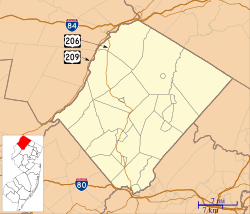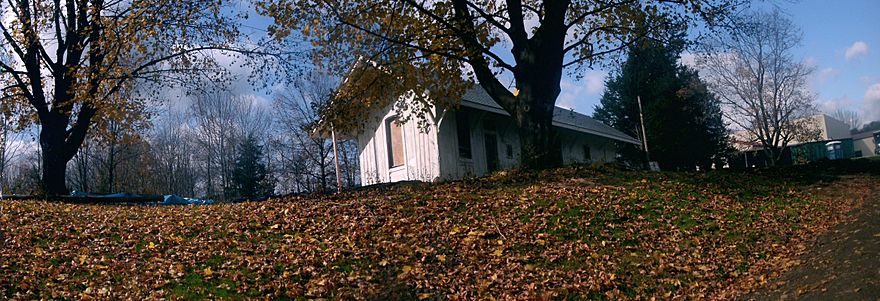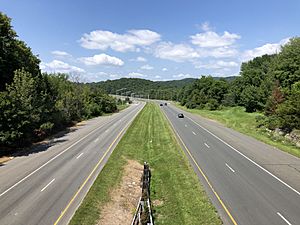Sparta, New Jersey facts for kids
Quick facts for kids
Sparta, New Jersey
|
||
|---|---|---|
|
Township
|
||
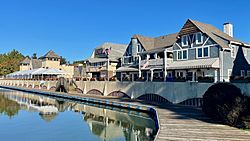
Lake Mohawk Boardwalk
|
||
|
||
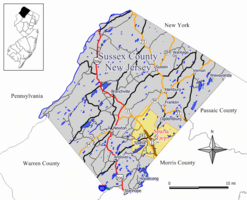
Location of Sparta in Sussex County highlighted in yellow (right). Inset map: Location of Sussex County in New Jersey highlighted in black (left).
|
||
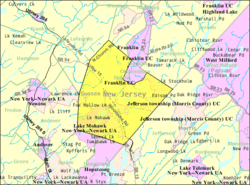
Census Bureau map of Sparta, New Jersey
|
||
| Country | ||
| State | ||
| County | ||
| Incorporated | April 14, 1845 | |
| Government | ||
| • Type | Faulkner Act (council–manager) | |
| • Body | Township Council | |
| Area | ||
| • Total | 38.80 sq mi (100.50 km2) | |
| • Land | 36.79 sq mi (95.28 km2) | |
| • Water | 2.02 sq mi (5.22 km2) 5.20% | |
| Area rank | 60th of 565 in state 5th of 24 in county |
|
| Elevation | 620 ft (190 m) | |
| Population
(2020)
|
||
| • Total | 19,600 | |
| • Estimate
(2023)
|
20,195 | |
| • Rank | 141st of 565 in state 2nd of 24 in county |
|
| • Density | 532.8/sq mi (205.7/km2) | |
| • Density rank | 440th of 565 in state 9th of 24 in county |
|
| Time zone | UTC−05:00 (Eastern (EST)) | |
| • Summer (DST) | UTC−04:00 (Eastern (EDT)) | |
| ZIP Code |
07871
|
|
| Area code(s) | 973 exchanges: 726, 729 | |
| FIPS code | 3403769690 | |
| GNIS feature ID | 0882265 | |
Sparta is a township located in Sussex County, New Jersey. It's a place where about 19,600 people live, based on the 2020 census. The township was officially created on April 14, 1845. It got its name from an older community in the area, which was likely named after Sparta, Greece.
Sparta is known for being a very safe place. In 2022, it was named the safest place in New Jersey and the seventh safest town in the entire country by Safewise.com.
Contents
History of Sparta
Early Days and Settlement
Long ago, the area where Sparta is now was home to the Lenape Native Americans. In the 1750s, Dutch explorers found red ores here and tried to mine copper.
The first permanent settlers arrived in 1778. Robert Ogden and his wife built their home and an iron forge. They named their new farm and house "Sparta." The first public building was the Presbyterian Church, built in 1786. Schools were set up in nearby Ogdensburg by 1806 and in Sparta by 1812.
Mining in Sparta
For over 100 years, mining was a big part of Sparta's economy. People mined iron, zinc, and limestone. Today, most mining has stopped. Sparta is now mostly a residential area with many small businesses.
Iron Mining
Robert Ogden started an iron forge in 1778, using local iron ore. Later, in 1868, the Ogden Mine Railroad made it easier to ship iron and zinc ore. This helped the mining business grow.
In 1836, Henry Decker and others started making anchors in Sparta. This was a successful small industry for a while. However, by the end of the Civil War, anchor making in Sparta stopped.
In 1889, Thomas Edison invested a lot of money in his Edison Ore-Milling Company. He wanted to get iron from the low-quality ore on Sparta Mountain. Edison's company employed 500 people at its busiest. But after 10 years, he gave up because it was cheaper to get iron from other places like Minnesota. This ended iron mining in Sparta.
Zinc Mining
In 1848, the New Jersey Zinc Company started mining zinc at Sterling Hill. The ores there were rich in zinc. By 1868, both iron and zinc were being mined at Sterling Hill.
Many companies had legal fights over mining rights. In 1880, the Franklin Iron Company took over the New Jersey Zinc Company's operations. Large-scale zinc mining began in 1897. By 1900, the mill was processing 1,500 tons of ore every day.
Zinc mining continued until 1986, when the Sterling Hill mine closed. Today, the mine site is the Sterling Hill Mining Museum. You can visit it and learn about mining history.
Limestone Quarrying
After his iron business failed, Thomas Edison opened a limestone quarry called Limecrest in 1919. This quarry provided limestone for Edison's Portland cement factories. The quarry operated for over 80 years, closing in 2003. It was an important source of jobs and money for Sparta. While limestone is no longer mined, a small amount of granite is still quarried today.
Tourism and Lake Mohawk
In 1872, the New Jersey Midland Railroad opened, bringing zinc ore traffic. In 1882, the line was extended, and a station was built in Sparta. This made it easy for tourists to visit. Many boarding houses opened for summer visitors from the cities.
Passenger train service ended in 1935. But by then, Sparta was a popular summer spot. In 1926, a company built a 600-foot dam across the Wallkill River. This created the 300-acre Lake Mohawk in 1928. This private resort community started with summer homes. By the 1940s, many homes were made ready for winter. Today, most of the 2,600 families living there stay all year.
Geography
Sparta Township is located in Sussex County. It shares borders with several other towns. These include Andover Township, Byram Township, Franklin Borough, and Hardyston Township. It also borders Hopatcong Borough, Lafayette Township, and Ogdensburg Borough in Sussex County. In Morris County, it borders Jefferson Township.
The township covers a total area of about 38.80 square miles (100.50 square kilometers). Most of this is land, with a small part being water.
Communities in Sparta
Several smaller communities and places are located within Sparta Township. Some of these include Ackerson, Edison, Hopewell, Lake Mohawk, and Sparta Junction.
Lake Mohawk
Lake Mohawk is a community that is partly in Sparta and partly in Byram Township. It's a well-known area within the township.
Sparta Junction
Sparta Junction is a historical spot where two railroad tracks crossed. It was once an important place for controlling train signals. Its coordinates are 41°03′51″N 74°40′17″W / 41.06426°N 74.67127°W.
Geology
Sparta is in an area called the Highlands. This region is made up of very old rocks, like igneous and metamorphic rock. These rocks were formed when continents collided a long time ago. This collision created the mountains you see in Sparta and to the north. The Wisconsin Glacier, a huge sheet of ice, also shaped the land. It created all the lakes and streams in the area.
Population and People
| Historical population | |||
|---|---|---|---|
| Census | Pop. | %± | |
| 1850 | 1,919 | — | |
| 1860 | 2,062 | 7.5% | |
| 1870 | 2,032 | −1.5% | |
| 1880 | 2,274 | 11.9% | |
| 1890 | 1,724 | −24.2% | |
| 1900 | 2,070 | 20.1% | |
| 1910 | 1,579 | −23.7% | |
| 1920 | 1,017 | −35.6% | |
| 1930 | 1,316 | 29.4% | |
| 1940 | 1,729 | 31.4% | |
| 1950 | 3,021 | 74.7% | |
| 1960 | 6,717 | 122.3% | |
| 1970 | 10,819 | 61.1% | |
| 1980 | 13,333 | 23.2% | |
| 1990 | 15,157 | 13.7% | |
| 2000 | 18,080 | 19.3% | |
| 2010 | 19,722 | 9.1% | |
| 2020 | 19,600 | −0.6% | |
| 2023 (est.) | 20,195 | 2.4% | |
| Population sources: 1850–1920 1850–1870 1850 1870 1880–1890 1890–1910 1910–1930 1940–2000 2000 2010 2020 * = Lost territory in previous decade. |
|||
Sparta has a population of about 19,600 people as of 2020. The town is known for having many pilots and their families living there. One author described Sparta as a place where pilots like to live because it's quiet and surrounded by trees, away from the busy city.
Economy
Sparta has many small businesses. In the Lake Mohawk area, you can find boutiques and gift shops. There are also several family-owned pizzerias and delis. For more shopping options, the Rockaway Townsquare mall is about 15 minutes away.
Education
Public Schools
The Sparta Township Public School District serves students from pre-kindergarten all the way through twelfth grade. The district has five schools:
- Alpine Elementary School (PreK-2)
- Mohawk Avenue School (Grade 3)
- Helen Morgan School (Grades 4-5)
- Sparta Middle School (Grades 6-8)
- Sparta High School (Grades 9-12)
The Sparta Education Foundation helps the public schools by raising extra money. They use these funds for things like new technology in classrooms.
Other Schools
Sparta is also home to:
- Sussex County Technical School: A high school that teaches technical skills.
- Sussex Charter School for Technology: A school for grades 6-8.
- Private schools: These include Rev. George A. Brown Elementary, Pope John XXIII Middle School, and Pope John XXIII High School. There is also Hilltop Country Day School and Veritas Christian Academy.
Transportation
Sparta has many roads, including Route 15, which is the main highway. Part of the old Route 15 is now called Route 181. Other important roads are Route 94 and County Route 517.
For public transportation, the Skylands Connect bus serves Sparta. It connects to nearby towns like Newton and Hamburg. Lakeland Bus Lines also provides bus service for people commuting to Midtown Manhattan in New York City.
Emergency Services
Police Department
The Sparta Police Department is located in the Municipal Building. It is led by Chief of Police Neil Spidaletto. The department has a dispatch center that operates 24/7. This center handles calls for police, fire, and medical emergencies for Sparta and nearby towns like Franklin and Ogdensburg.
Ambulance Squad
The Sparta Ambulance Squad was started in 1947. It has both volunteers and paid EMTs (Emergency Medical Technicians). During weekdays, paid EMTs staff the ambulances. On evenings and weekends, volunteers are on call. The squad has three ambulances and other emergency vehicles. They respond to many calls each year to help people in need.
Fire Department
The Sparta Fire Department provides firefighting services to the township. They also help with vehicle accidents and hazardous material situations. The main fire station is on Woodport Road, with other stations on Glen Road and Sparta Stanhope Road.
Notable People
Many interesting people have lived in or are connected to Sparta:
- Mary Vail Andress, a banker and World War I relief worker.
- Greg Baty, a former NFL football player.
- Mike Budnik, a former professional inline skater and mixed martial arts fighter.
- Cassidy, lead singer for the band Antigone Rising.
- Tom Caltabiano, a writer and comedian.
- Frank Dolce, an actor who appeared on TV and Broadway.
- Charles Joseph Fletcher, an inventor and business owner.
- Archimedes Giacomantonio, a sculptor known for his busts.
- Bob Gunderman, an NFL football player for the Pittsburgh Steelers.
- Frank Herbert, a politician who served in the New Jersey Senate.
- Chris Jent, a former NBA basketball player and coach.
- F. Ross Johnson, a Canadian businessman and former CEO of RJR Nabisco.
- Jordan Lawlor, a musician who has toured with M83.
- Jeff Lenosky, a US National Mountain Bike Champion.
- Simon J. Levien, a journalist.
- Sean Maguire, a football quarterback.
- Wendy Mass, an author.
- Dan Miller, a mixed martial artist and UFC Contender.
- Jim Miller, a mixed martial artist and UFC Contender.
- Troy Murphy, an NBA basketball player.
- Sylvia Pressler, a New Jersey court judge.
- Tom Raney, a comics artist.
- J. Allyn Rosser, a poet.
- Jack Thomas Smith, a horror filmmaker.
- Tim Sweeney, a former professional baseball player and sports agent.
- Arthur Tipton, a football player and United States Army officer.
- Russ Van Atta, a former Major League Baseball pitcher and local sheriff.
- Harry Wright, a football player, coach, and former mayor of Sparta.
See also
 In Spanish: Municipio de Sparta (Nueva Jersey) para niños
In Spanish: Municipio de Sparta (Nueva Jersey) para niños



